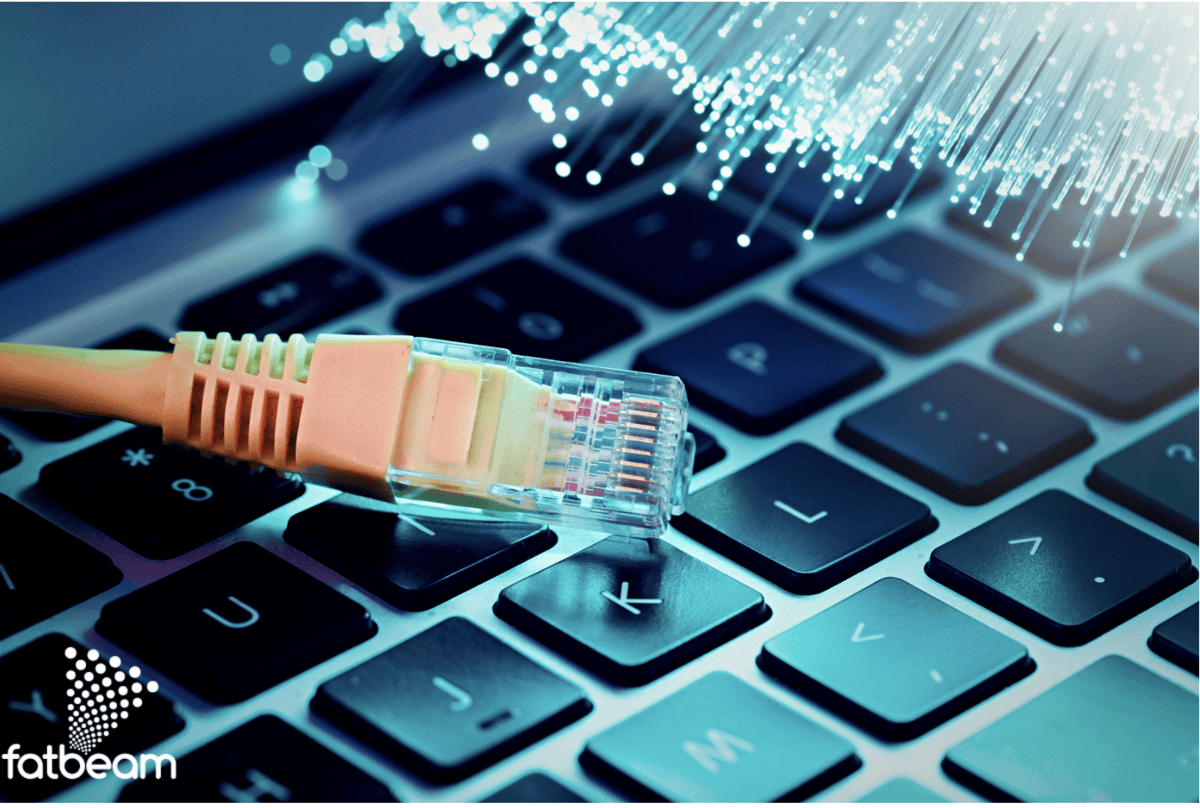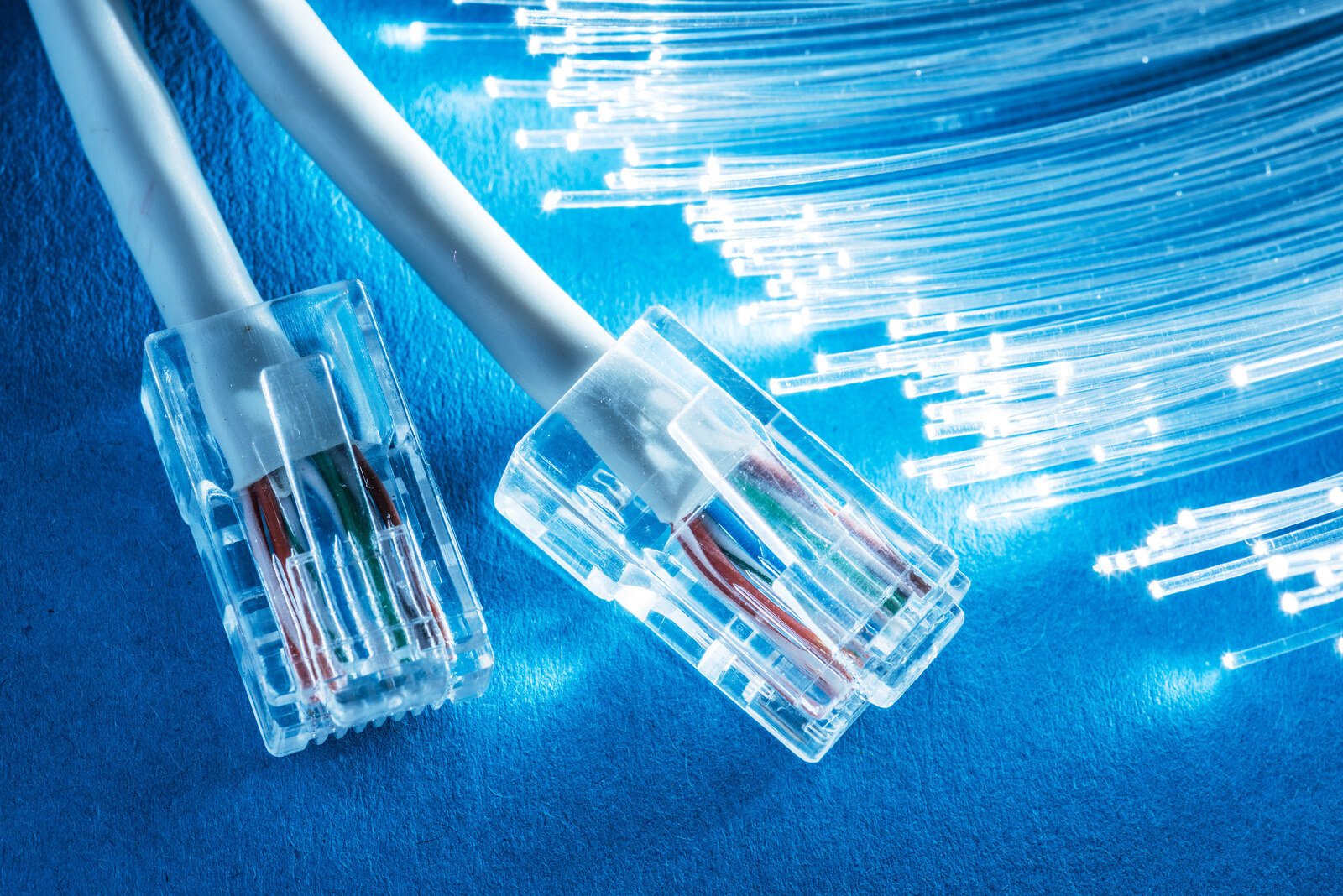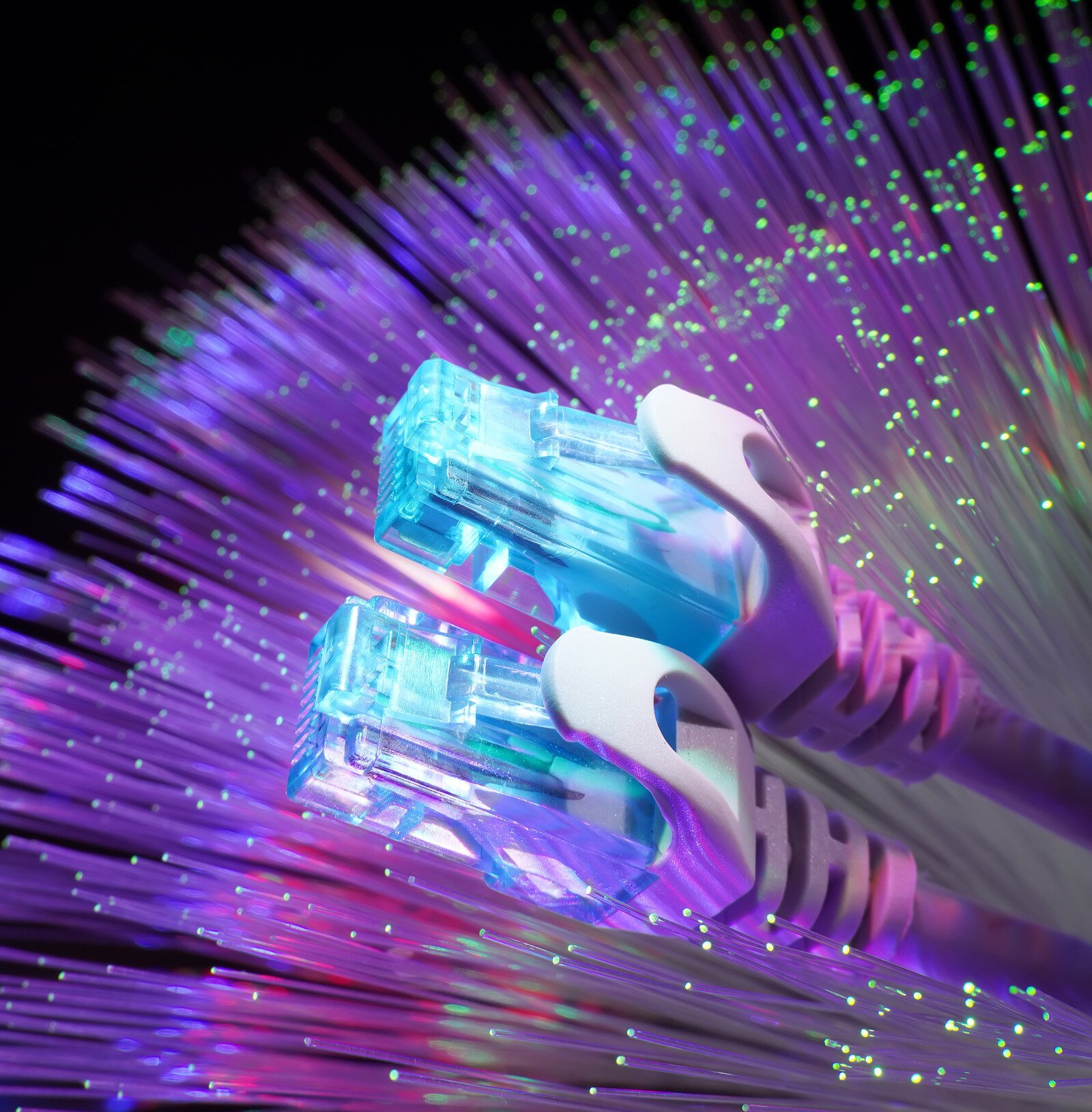Fiber internet adoption is skyrocketing. Recent stats show that 45% of U.S. households have access to fiber-to-the-home (FTTH) connections – and that number is only going up.1 But do you know what goes on behind the scenes to bring that high-speed connection to your doorstep?
In this blog, we'll walk you through how this advanced technology works, what to expect during installation, and why fiber is the stress-free internet solution you've been waiting for.
What Is Fiber Optic Internet?
Think of fiber internet as the express lane of the digital highway. Instead of sending signals over copper wires, fiber optic technology harnesses the power of light to transmit data at much faster speeds than other internet services.
Here's a quick breakdown:
- Fiber optic cables use very thin strands of plastic or glass (about as thick as a human hair).
- Data is converted into pulses of light.
- These light pulses travel through the fiber cables at the speed of light.
The result? Internet that performs 10 to 20 times faster than traditional DSL options.2
But speed isn't the only advantage of fiber. This technology is built to handle massive amounts of data without slowdowns. That means no more buffering, lagging, or frustrating delays – even when the whole family is online.

How Does Fiber Optic Internet Work?
Fiber Optic Cables
Fiber optic cables are made of very thin strands of plastic or glass, each approximately as thick as a human hair. These cables are designed to transmit data over long distances with minimal loss of signal quality.
Data Transmission
In fiber optic internet, data is converted into pulses of light. These light pulses carry information through the fiber cables, allowing for incredibly fast and efficient data transfer.
Speed Of Transmission
The light pulses travel through the fiber cables at the speed of light, making fiber optic internet one of the fastest and most reliable methods of data transmission available today.
Fiber Optic Internet vs 5G | 4 Key Differences
Technology
Fiber optic internet relies on a network of fiber optic cables that transmit data using light signals. These cables are made of thin strands of glass or plastic, which allows data to be sent over long distances at incredible speeds without significant loss of quality.
5G is the fifth generation of wireless mobile network technology. It delivers internet wirelessly using radio waves via a network of cellular towers. This allows users to connect to the internet without needing cables.
Speed & Performance
Fiber can provide symmetrical speeds (equal download and upload speeds), often reaching up to 1 Gbps or higher. The connection is highly stable and reliable, making it ideal for heavy data usage like streaming in 4K, video conferencing, and large file uploads.
5G can reach high speeds, comparable to fiber in certain locations, with theoretical maximum speeds of up to 10 Gbps. However, actual speeds depend on proximity to a 5G tower and the level of network congestion. Unlike fiber, 5G speeds can vary widely depending on factors like terrain, obstacles, and how many users are connected at the same time.
Reliability
Fiber optic connections are more consistent because they are less affected by external factors like weather, electromagnetic interference, or the number of people using the service in your area. It’s a dedicated line that is usually less congested than other types of internet.
While 5G offers faster speeds than previous mobile technologies, it is still subject to network congestion and interference from buildings, trees, and weather. Also, the highest speeds (millimeter-wave 5G) have a shorter range and may require being close to a 5G node for optimal performance.
Best For
Fiber is ideal for home and business environments where speed and reliability are crucial. It’s excellent for bandwidth-intensive activities such as gaming, working from home, running smart homes, or supporting multiple devices simultaneously.
5G is ideal for mobile users who need high-speed internet on the go. It’s also a good option for rural areas where fiber optic cables may not yet be installed or for temporary setups like outdoor events or construction sites where physical infrastructure isn’t available.
How Is Fiber Internet Installed?
Getting fiber installed in your home is easier than you might think. In fact, it's similar to setting up traditional internet. If you're thinking about making a fiber internet installation appointment, a good place to start is to make sure your internet service provider offers fiber optic internet service in your area. Once you've confirmed the availability of fiber, here's what you can expect:
Site Survey
A technician will assess your property to plan the cable route. This step ensures your fiber provider can offer the best possible connection while minimizing any disruption to your property. They'll consider factors such as existing utilities, landscaping, and your home's structure.
Exterior Installation
The tech runs the fiber optic cable from the nearest access point to your home. This might involve some digging, but fiber service providers use advanced techniques like micro-trenching to install the fiber quickly and with minimal impact on your yard or driveway.
Entry Point Creation
The technician creates a small entry point to bring the fiber cable into your home. It's a minor modification that is carefully sealed to protect against the elements and maintain your home's energy efficiency.
ONT Installation
They then set up the optical network terminal (ONT), which is the bridge between the outdoor fiber network and your home's internal network. The tech will place it in a convenient location that ensures optimal signal strength throughout your home.
Router Setup
The technician connects and configures your fiber internet router to get you up and running. During this step, they make sure your Wi-Fi network is set up securely and help connect your devices to the new network.
Testing & Optimization
Lastly, the tech runs thorough tests to ensure your fiber internet is working at peak performance. This includes speed tests, signal strength checks, and verifying that all your devices can connect properly.
How Much Does It Cost To Install Fiber Internet?
Let's talk numbers. For you, the consumer, fiber internet installation is surprisingly affordable. Many providers (including us!) offer free or discounted installation for new customers. Even when there is an installation fee, it's typically in the $50-$150 range.

For providers like Fatbeam Fiber, however, the investment is significantly more substantial. Building out a fiber network requires considerable capital expenditure. Here's a breakdown of the major costs involved:
Infrastructure Development
The biggest expense is typically laying the fiber optic cables themselves. This can cost thousands of dollars per mile in urban areas and potentially more in rural areas.
Labor Costs
Fiber networks require skilled technicians for planning, installation, and maintenance. Due to their specialized expertise, these professionals command higher wages.
Permits & Rights-of-Way
Obtaining the necessary permits from local authorities can be a time-consuming and expensive process. Securing rights-of-way to lay fiber across private or public property often involves negotiations and fees.
Equipment
Providers must invest in specialized equipment for installing and maintaining fiber networks, including fusion splicers, optical time-domain reflectometers (OTDRs), and other high-tech tools.
Ongoing Maintenance
While fiber networks are extremely reliable, providers must factor in the cost of ongoing maintenance and potential repairs.
Customer Premises Equipment
Providers often subsidize or provide the necessary equipment, such as optical network terminals (ONTs) and routers, at the customer's location for free.
When all these factors are considered, the total cost for a provider to deploy fiber optic internet in a new area can easily run into millions of dollars. But here's the bottom line: both consumers and providers agree that fiber is a worthwhile investment. For you, it means unbeatable speed and reliability that'll transform how you work, play, and connect online.
Top 5 Benefits Of Fiber Optic Internet
The enthusiasm around fiber internet is completely justified. The right fiber provider can deliver benefits such as:
Fast Speeds for Seamless Connectivity
We're talking up to 2 Gbps in some areas. Downloads that used to take hours take minutes or even seconds with fiber. This incredible speed allows you to stream 4K videos, download large files, and engage in video conferences without any lag or buffering. Multiple users in your household can enjoy high-bandwidth internet connections simultaneously without slowing each other down.

Solid Reliability for a Stable Connection
Unlike traditional copper cables, fiber cables resist weather and wear and tear exceptionally well. They also aren't affected by electromagnetic interference or temperature fluctuations, which means fewer outages and more consistent performance – even during severe weather conditions or peak usage times.
Symmetrical Speeds for Faster Uploads & Downloads
Traditional internet often offers much slower upload speeds, which can be frustrating when you're trying to share large files or participate in video calls. With fiber's symmetrical speeds, you can upload and download at the same fast rate, making your online experience smoother and more efficient.
Low Latency for Real-Time Responsiveness
Fiber's low latency means your online activities happen in real-time, giving you a seamless experience. This translates to crystal-clear remote work or school video conferences without awkward delays or frozen screens. Low latency also eliminates buffering or lag when you're watching your favorite shows or live events. You'll enjoy smoother playback and faster load times, even when streaming in 4K quality.
Future-Ready Technology
As internet needs evolve, fiber has the capacity to keep up without missing a beat. The bandwidth capacity of fiber optic cables far exceeds current needs, which means your connection can easily handle increasing demands for faster speeds and higher data usage in the future. This makes fiber internet a smart, long-term investment for your home or business connectivity needs.
Is Fiber Internet Available In Your Area?
At Fatbeam Fiber, we've made it easy to see if fiber internet is available in your area. Simply visit our website and click the "Check Availability" button. Enter your address, and within seconds, you'll know if you can access our world-class fiber internet.
Our extensive network spans eight states in the Western U.S., bringing lightning-fast fiber connectivity to over 150 cities. But even if fiber service isn't available at your address today, it could be coming soon. We're constantly expanding our network and plan to reach even more communities in the near future. Our aggressive expansion plans currently include new residential services in Boise, ID, and business and education services in several Washington cities.

Fiber Optic Internet Installation FAQs
Got questions? We've got answers:
Do I need a modem for fiber internet?
No, fiber uses an optical network terminal (ONT) instead. The ONT converts optical fiber signals into electrical signals that your devices can use. Our technicians will ensure this crucial equipment is properly installed and configured for optimal performance.
How reliable is fiber internet?
Fiber internet service is extremely reliable. Here's why:
- Fiber is less affected by weather, interference, and other factors that can disrupt DSL or cable internet.
- The plastic or glass fibers used in fiber optic cables don't conduct electricity, making them immune to electromagnetic interference.
- Fiber cables are less susceptible to temperature fluctuations and physical damage than Ethernet or coaxial cables.
Thanks to these features, fiber offers a more reliable connection with fewer outages and consistent speeds, even during peak usage times.
Can I install fiber internet myself?
No, installing fiber optic internet is not a DIY process. Unlike cable or DSL, which may allow for self-installation in some cases, fiber requires specialized equipment, precise handling, and professional expertise to ensure a successful setup.
Here’s why fiber installation must be done by a professional:
Fiber Optic Cable Handling
Fiber optic cables are made of thin strands of glass that transmit data using light. They are delicate and require specialized tools for splicing and terminating connections without damaging the fibers.
Optical Network Terminal (ONT) Installation
Fiber internet does not use a traditional modem. Instead, it requires an ONT to convert light signals into digital data. Installing and configuring an ONT correctly requires technical knowledge.
Connection to ISP Network
Fiber installations require the ISP’s technicians to connect your home to the nearest fiber node, either through underground conduit or aerial fiber lines on utility poles. This process often involves trenching, drilling, or running new lines, which must meet local regulations and safety standards.
Fiber Splicing
If fiber cables need to be joined, a technique called fusion splicing is used, which requires specialized equipment that melts the fiber ends together to create a seamless connection. This process must be done by trained technicians to ensure minimal signal loss.
Regulatory and Safety Concerns
Digging to lay fiber cables requires permits and coordination with local authorities to avoid damaging underground utilities like gas or water lines. ISPs handle this process to comply with local laws.
While inside wiring for fiber internet (such as running an Ethernet cable from the ONT to a router) can be done by the homeowner, the actual fiber installation must be performed by an ISP-certified technician.
Will fiber optic installation damage my property?
Our technicians are experts at minimizing disruption. Before we begin the installation, we'll conduct a thorough site survey to determine the least intrusive way to bring fiber to your home. If any digging is necessary, we use precise, narrow trenching methods that cause minimal damage to your lawn or driveway. We always clean up after the installation and restore any affected areas to their original condition.
How long does it take to get fiber internet installed?
Typically, a standard fiber internet installation will take four to six hours. The specific time frame will depend on factors like the layout of your property and whether we can use existing infrastructure or need to run new fiber optic cable. Our technicians will give you a more precise estimate when they arrive for the installation. We respect your time and strive to complete the installation with minimal disruption to your day.
Will fiber optic internet work with my existing router?
Fiber optic internet may or may not work with your existing router, depending on its specifications. Unlike cable or DSL connections, fiber requires a router that connects to an Optical Network Terminal (ONT) via an Ethernet WAN port. If your current router supports gigabit speeds and is compatible with your provider’s network, it should work. However, older routers that only support lower speeds or lack the necessary WAN port may limit performance. Some fiber ISPs require specific router configurations, so it's best to check with your provider to confirm compatibility. If you’re upgrading to fiber, investing in a fiber-ready, high-speed router can help ensure you get the most out of your new connection.
Get Fast, Affordable Fiber Internet With Fatbeam
From its fast speeds to its rock-solid reliability, fiber is changing the game when it comes to how we connect online. Whether you need internet for work, school, or just a buffer-free Netflix binge, fiber has you covered.
Fatbeam's fiber network spans over 150,000 miles across eight U.S. states and 150+ cities, delivering lightning-fast internet to thousands of satisfied customers. With Fatbeam, you get a partner that makes it as easy and cost-effective as possible to get started with fiber. No contract, no data cap, and no installation fee – just fast, affordable fiber internet that keeps up with your digital life.
Why Choose Fatbeam Fiber?
Simplified Billing
Our invoices are straightforward and easy to understand, so you can stay within your budget.
Fast Repairs
Life is full of challenges, but getting your internet back up if it goes down shouldn’t be one of them.
Local Tech Support
Our local technicians and 24/7 network operations center are here to help any time you need us.
Ready to get started with stress-free connectivity? Check if Fatbeam's high-speed fiber internet is available in your area today.
Sources:


